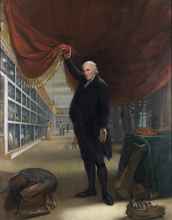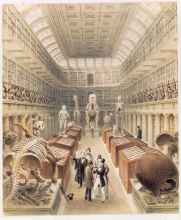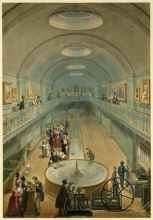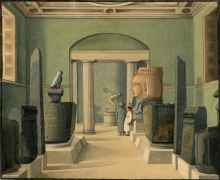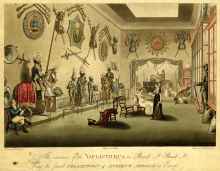Peale’s American Museum
In this self-portrait, artist and curator Charles Willson Peale depicts himself lifting a gold-fringed red curtain to reveal his museum, while inviting the viewer to come forward and enter. The hall behind him is on the second floor of Philadelphia’s Independence Hall, known from 1802 to 1854 as Peale’s American Museum.
The Hunterian Museum
This image documents the “Crystal Room” of the Royal College of Surgeons (RCS) as it was arranged in 1842. The two foremost specimens are a skeleton of the Mylodon (a large land-sloth from the ice age) on the left, and an armored shell of the Glyptodon (a large relative of the armadillo, also from the ice age) on the right.
National Gallery of Practical Science
George Scharf’s 1832 watercolor depicts the interior of the main hall in the National Gallery of Practical Science, Adelaide Street, on the north side of the Lowther Arcade, West Strand, London.
British Museum
This watercolor captures a view of the British Museum’s Egyptian Room, and a portion of the Townley Gallery beyond, as they appeared in 1820. Visible in the Egyptian Room are a series of monumental stone sculptures, placed on low plinths, that run along either side of the central walkway.
Thomas Gwennap’s “Oplotheca”
This image depicts the interior of Thomas Gwennap’s “Oplotheca” (derived from the Greek term hoplothêkê, meaning armory) at no. 20, Lower Brook St., London, as it was arranged in 1816. On the left side of the image, along the wall, stand three full suits of armor, flanked by two armored equestrians.

